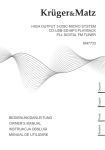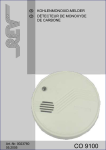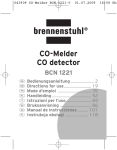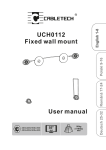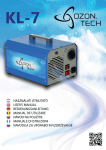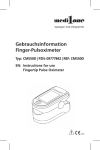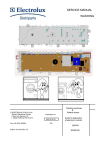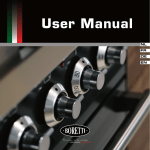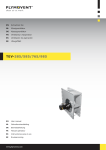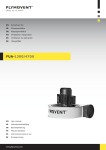Download URZ0408
Transcript
CARBON MONOXIDE DETECTOTR URZ0408 Bedienungsanleitung DE Owner’s manual EN Instrukcja obsługi PL Manual de utilizare RO Bedienungsanleitung KOHLENMONOXID DETEKTOR URZ0408 WICHTIGE WARNUNGSHINWEISE WARNUNG: Lesen Sie alle Anleitungen vor der Installation und bewahren Sie die Bedienungsanleitung in der nähe des Detektors für späteres nachschlagen. WARNUNG: Durchs entfernen der Gleichstromspannung wird der Alarm unwirksam. Unser Kohlenmonoxid-Detektor erfordert eine kontinuierliche elektrische Spannungsversorgung, er wird nicht ohne Strom funktionieren. Kohlenmonoxid Alarme können unwirksam werden, weil sie elektronische Bauteile enthalten, die jederzeit scheitern können. Testen Sie den Alarm mindestens einmal pro Woche (siehe Abschnitt “Testen”). Wenn der Testbetrieb NICHT funktioniert, bitte mit einem Neuen ersetzen, und senden den defekten Detektor für Service. WARNUNG: Dieses Produkt ist für den Einsatz in normalen Innenräumen der Familien-Wohneinheiten vorgesehen. Es ist nicht zum messen für die Einhaltung der Arbeitssicherheit und Gesundheitsverwaltung gewerblichen oder industriellen Standards. Der Alarm wurde nicht für Kohlenmonoxid Erkennung unter 40 ppm geprüft, einzelne Personen mit medizinischen Problemen sollten die Benutzung von Warneinrichtungen in betracht ziehen, die akustische und optische Signale für Kohlenmonoxid-Konzentrationen unter 30 ppm hervorbringen. VORSICHT: Dieser Alarm zeigt das Vorhandensein von Kohlenmonoxid am Sensor. Kohlenmonoxid kann in anderen Bereichen vorhanden sein. VORSICHT: Unterkunftsräume sollten gut belüftet werden, wenn HaushaltsReinigungsmittel oder ähnliche Verunreinigungen eingesetzt werden. Wichtig: Dieser Kohlenmonoxid-Alarm ist nur für die Erkennung von Kohlenmonoxid-Gas von JEDER Verbrennungsquelle vorgesehen. Er ist nicht für die Erkennung von Rauch, Feuer oder irgendwelche anderen Gase vorgesehen. 1. EINLEITUNG Unser Alarm für Kohlenmonoxid (CO) ist vorgesehen zur Überwachung der Luft nach CO Gehalt. In Ihrem Heim oder Büro. Der Alarm ertönt wenn unabhängig potenziell gefährliche Werte existieren. Das Gerät wird mit 230V/50Hz Wechselstrom versorgt. Die Merkmale des CO Gasalarm sind: (1) Einfache Installation. (2) Ununterbrochene Überwachung nach Kohlenmonoxid. (3) Lauter Alarm-Ton (85 dB/3 m) bei der Erkennung von KohlenmonoxidAnreicherung. (4) Besitzt eine Testtaste um den Alarm jederzeit zu testen. (5) Unnuterbrochener Selbsttest seiner operativen Funktionen. DE 3 Bedienungsanleitung (6) Erfüllt die Anforderungen von EN50291. (7) Anzeige des Endes des Sensorlebens. (8) Bietet eine 5 Jahresgarantie für den Kohlenmonoxid-Alarm und das Lebensende ist abhängig vom Herstellungsdatum. 2. SYMPTOME EINER KOHLENMONOXID-VERGIFTUNG Folgende Symptome sind einer Kohlenmonoxid-Vergiftung zuzuordnen und sollten mit allen Mitgliedern des Hausehalts besprochen werden, um zu wissen auf was sie achten sollen: (1) Schwache Aussetzung: Leichte Kopfwehen, Übelkeit, Erbrechen, Müdigkeit. (2) Mittlere Aussetzung: starke pochende Kopfschmerzen, Benommenheit, Verwirrtheit, Erbrechen, Herzrasen. (3) Extreme Aussetzung: Bewusstlosigkeit, Krämpfe, Hertz-Kreislaufstörung, Tod. (4) Viele gemeldete Fälle von KOHLENMONOXID-VERGIFTUNG zeigen dass, während die Opfer sich bewusst sind, dass sie sich nicht gut fühlen, so desorientiert sind, dass sie nicht in der Lage sind, sich zu retten, entweder durch Verlassen des Gebäudes oder Aufrufe um Hilfe. Kleine Kinder und Haustiere sind in der Regel als erste betroffen. (5) Aussetzen während des Schlafs ist besonders gefährlich. DE 4 3. STANDORTE UM DEN ALARM ANZUBRINGEN Da CO-Gas sich frei in der Luft bewegt, ist der vorgeschlagene Standort im oder so nahe wie möglich am Schlafbereich des Hauses anbringen. Der menschliche Körper ist besonders anfällig für die Auswirkungen von CO-Gas während der Schlafstunden. Für maximalen Schutz sollte sich ein CO-Alarm in oder in der Nähe des Schlafzimmers und Wohnbereichs befinden. Es wird empfohlen, dass Sie einen CO-Alarm auf jeder Ebene eines Mehrstöckigen Hauses installieren. Sie können die Anzahl und Lage der Rauchmelder in Ihrem Haus nach den aktuellen Bauvorschriften installiert, als Leitfaden für den Standort Ihres CO-Alarm nutzen. In der folgenden Abbildung werden vorgeschlagen Standorten im Hause angezeigt. Bedienungsanleitung BEI DER AUSWAHL IHRES AUFSTELLUNGS-ORTES, STELLEN SIE SICHER, DASS SIE DEN ALARM VON ALLEN SCHLAFBEREICHEN HÖREN. WENN SIE SIE NUR EIN KOHLENMONOXYDALARM IN IHREM HAUSE INSTALLIEREN, SOLLTE DIE INSTALLATION DES ALARM BEIM SCHLAFZIMMER ERFOLGEN UND NICHT IM KELLER ODER HEIZRAUM. Zwei selbstklebende Etiketten werden mit dem CO Alarm mitgeliefert. Tragen Sie die Telefonnummer Ihres Notrufdienstes auf dem Etikett in den vorgesehenen Platz. Ein Etikett sollte in der Nähe des Alarms angebracht werden und eines in der Nähe einer Frischluftquelle, wie Fenster oder Türe. WICHTIG: Dieses Gerät ist nicht geeignet für die Installation in gefährlichen Standorten wie vom National Electrical Code definiert 4. STANDORTE UN DEN DER ALARM NICHT ANZUBRINGEN WICHTIG: ungeeignete Stelle können die empfindlichen elektronischen Komponenten in diesem CO-Alarm beeinflussen. Stellen Sie den Alarm NICHT in folgenden Bereichen auf: (a) Es wird nicht empfohlen, dass Sie diese CO in Garagen, Küchen oder Ofenräume installieren. Installation in diesen Bereichen könnten zu Fehlalarmen führen, kann den Sensor an Stoffen aussetzen, die diesen beschädigen oder verunreinigen, oder der Alarm wird nicht von Personen in anderen Bereichen des Hauses gehört werden, vor allem, wenn sie schlafen. (b) In der Garage kann Fahrzeugabgas etwas Kohlenmonoxid enthalten. Diese Werte sind höher, wenn der Motor zum ersten Mal gestartet wird. Auch Stunden nach Beginn eines Fahrzeug-Starts und entfernen aus der Garage, kann das gegenwärtige Niveau den Alarm aktivieren und zu einem Ärgernis werden. (c) In der Küche und Ofenraum, einige Gasgeräte können einen kurzen Ausbruch von Kohlenmonoxid beim Einschalten emittieren das ist normal. Wenn Ihr CO-Alarm zu nahe an diesen Geräten eingebaut ist, kann es oft Alarm auslösen und zu einem Ärgernis werden. (d) Wenn Sie einen CO-Alarm in der Nähe von Koch- oder Heizgeräten installieren, in einem Abstand von wenigstens 5 Fuß (1,5 Meter) vom Gerät installieren. (e) Nicht installieren in Bereichen in denen die Temperaturen unter 40°F (4,4°C) fallen oder 100°F (37,8°C) überschreiten. (f) Nicht in übermäßig staubigen, schmutzigen oder fettigen Bereichen installieren wie Küchen, Garagen und Ofenräume. Staub, Fett oder Haushaltschemikalien können den Sensor des Alarms verunreinigen oder überziehen, wodurch der Alarm nicht richtig funktioniert. (g) Die Lüftungsschlitze an der Oberseite und der Unterseite des Alarms DE 5 Bedienungsanleitung nicht behindern. (h) Nicht in der Nähe von Türen und Fenstern, die nach außen öffnen, in der Nähe Frischluftzufuhr, oder überall dort, zugig ist installieren. Vermeiden Sie folgendes: Übermäßige Verschütten oder Rückwärtige Entlüftung von Brennstoffgeräte von Außenumgebungs-Bedingungen verursacht von: (1) Windrichtung und / oder Geschwindigkeit, inklusive hohe Windböen, starke Luftströmungen in Lüftungsleitungen (kalte / feuchte Luft mit längeren Zeitraum zwischen den Zyklen). (2) Negative Druckdifferenz durch die Verwendung von Abluftventilatoren. (3) Der gleichzeitige Betrieb von mehreren Brennstoffgeräten im Wettbewerb um begrenzte interne Luft. (4) Lose schwingende Lüftungsrohrverbindungen von Wäschetrocknern, Öfen oder Warmwasser-Breiter. (5) Hindernisse in oder unkonventionelle Entlüftungsrohr-Designs, die die oben genannte Situation verstärken können. Erweiterter Betrieb von unbelüfteten Brennstoffverbrennungsgeräten (Herd, Backrohr, Kamin, usw.) Temperatur-Inversion die Abgase in Bodennähe einfangen kann. Auto im Leerlauf in offener oder geschlossener angebauter Garage, oder in der Nähe eines Hauses. 5. INSTALLATION DES ALARMS Unser CO-Alarm wird an der Decke oder wenn nötig an der Wand montiert werden. Da unser CO-Alarm ein Signal-Station Typ ist, kann dieser nicht mit anderen Alarmsystemen verbunden werden. DE Bitte befolgen Sie die nächsten Schritte zur Installation des CO-Alarms: (1) Montagehalterung vom Gerät entfernen. (2) Halterung an die Wand halten. Von jedem Befestigungsloch eine Markierung auf der Wand machen um einen Dübel mit Schraube anzubringen. (3) Halterung entfernen. (4) Mit einem a 3/16-Zoll (5mm) Bohrer, bohren Sie zwei Löcher an den Markierungen und stecken zwei Plastikdübel ein. (5) Alarm an die Halterung anpassen und auf die Halterung und nach unten auf die Dübel drücken. (6) Gerät an das Stromnetz anschließen. HINWEIS: Wenn Sie den Alarm zum ersten Mal einschalten, kann der Alarm einmal ertönen. Die grüne LED leuchtet ständig. Dieses ist normal und zeigt korrekte Stromversorgung an. Der CO-Alarm braucht eine Minute zum aufwärmen, danach drucken Sie die Taste. Ein lauter pulsierender AlarmTon ist zu hören. Das heißt der Alarm funktioniert einwandfreibutton. 6 Bedienungsanleitung Power Alarm Fault Test/Hush Buzzer 6.TASTE TEST/ALARM AUS Testen: Die grüne LED leuchtet ständig, um den Alarm zu testen, drücken Sie die Taste Test/Alarm Aus; die rote LED blinkt drei mal und der Alarm ertönt laut. Wenn der Testbetrieb NICHT funktioniert, bitte mit einem Neuen ersetzen, und senden den defekten Detektor für Service. Alarm ausschalten: Wenn der Alarm ertönt, können Sie die Taste Test/Alarm Aus drücken um den Alarm auszuschalten. Der Alarm-Ton verstummt und ertönt erneut nach 15 Minuten wenn die Konzentration von Kohlenmonoxid um den Alarm bei 40 ppm verbleibt oder diesen Wert überschreitet. 7.WARTUNG DES ALARMS Sie müssen den Alarm regelmäßig warten um einwandfreie Funktion zu erhalten. Hier einige Hinweise zur Wartung des Alarms Was Sie tun sollten: (1) Testen Sie den Alarm wöchentlich durch drücken der Taste Test/Alarm Aus. (2) Alarmgehäuse einmal im Monat mit einem Staubsauger reinigen, um angesammelten Staub zu entfernen. Benutzen Sie die weiche Bürste. Ihres Staubsaugers und trennen Sie den Alarm vor dem Reinigen vom Stromnetz. (3) Unterweisen Sie Ihre Kinder nie den Alarm zu berühren, vom Netz zu trennen oder in andere Weise mit dem Alarm einzumischen, warnen Sie Ihre Kinder vor der Gefahr der CO Vergiftung. Was Sie nicht tun sollten: (1) Verwenden Sie nie Waschmittel oder Verdünner um den Alarm zu reinigen. Chemikalien können den Sensor unwiderruflich beschädigen oder zeitweilig kontaminieren. (2) Vermeiden Sie das versprühen von Luft-Erfrischen, Haarspray, Farbe oder andere Aerosols in der nähe des Alarms. (3) Den Alarm nicht färben. Farbe versiegelt die Lüftungen und beeinträchtigt richtigen Sensor-Betrieb. (4) Den Alarm nicht direkt über oder in der Nähe eines Windeleimers montieren, da hohe Mengen an Methangas vorübergehenden Messwerte DE 7 Bedienungsanleitung auf der Digitalanzeige verursachen können. HINWEIS: Sollten Sie Holzböden oder Möbel beizen oder abschälen, Malen, Wand-Tapezieren oder Aerosole oder Klebemittel für die Selbstbauprojekt oder Hobby verwenden; Bevor Sie beginnen: bringen Sie den Alarm an einen entfernten Ort, um mögliche Schäden oder Verschmutzung des Sensors zu vermeiden. Sie möchten vielleicht den Alarm vom Netz trennen und in einem Kunststoffbeutel während des Projekts aufbewahren. Das folgende ist eine Liste der Stoffe, die in hohen Konzentrationen den Sensor beeinflussen können und zu vorübergehenden Messwerte auf der digitalen Anzeige verursachen können, die nicht Kohlenmonoxid-Werte sind: Methan, Propan, Isobutan, Ethylen, Ethanol, Alkohol, Isopropanol, Benzol, Toluol, Ethylacetat, Wasserstoff, Schwefelwasserstoff, Schwefeldioxid. Auch die meisten Sprays, Alkohol basierende Produkte, Farben, Verdünner, Lösungsmittel, Klebstoffe, Aftershaves Parfums, Autoabgasen und einige Reinigungsmittel. DE 8. ALARMFUNKTIONEN (a) Normale Funktion: bei normaler Funktion leuchtet ständig nur die grüne LED. (b) Alarm Status: wenn das Gerät einen gefährlich hohen Gehalt von CO Gas erkennt, ertönt das Alarmsignal ununterbrochen. Die rote LED blinkt und das Gerät gibt 3 kurze Alarm-Töne jede 5 Sekunden. Das Alarmmuster ist 3 kurze Töne gefolgt von 2 Sekunden Pause. (c) Alarm-Aus-Status: wenn nötig, können Się die Taste Test/Alarm Aus drucken um ungewünschten Alarm auszuschalten. Der Alarm-Ton verstummt und ertönt erneut nach 15 Minuten wenn die Konzentration von Kohlenmonoxid um den Alarm bei 40 ppm verbleibt oder diesen Wert überschreitet. (d) Fehlerstatus: wenn das Gerät eine Fehlfunktion entdeckt, wie z.B. Sensordefekt, blinkt die gelbe LED zweimal jede 60 Sekunden. Wenn dieses geschieht, diesen Alarm NICHT BENUTZEN. Das Gerät muss repariert oder ausgetauscht werden. Senden Się das defekte Gerät zum Hersteller für Reparatur. 9. TECHNISCHE DATEN: - Gaserkennung: Kohlenmonoxid - Detektorprinzip: Elektro-Chemische Zelle - Spannungsversorgung: AC230V/50Hz - Hörbarer Alarm: 85db/3M - Betrieb 40°F (4,4°C) bis 100°F (37,8°C) - Feuchtigkeitsbereich: 15-90(%RH) - Abmessungen: 104*70*55mm 8 Bedienungsanleitung KOHLENMONOXID REAKTIONSZEITEN Dieser Kohlenmonoxid-Alarm erfüllt die Bedingungen des EN Standard 50291 wie folgt: - 50 ppm Alarm im Zeitraum 60-90 Minuten - 100ppm Alarm im Zeitraum 10-40 Minuten - 300ppm Alarm im Zeitraum 3 Minuten DE Vertrieben durch LECHPOL Electronics BV, Nijverheidsweg 15 4311RT Bruinisse, Niederlande. 9 Owner’s manual CARBON MONOXIDE DETECTOR URZ0408 IMPORTANT WARNING STATEMENTS WARNING: Read all instruction before installation and keep the User’s Manual near the alarm for future reference. WARNING: Removal of the AC power will render the alarm inoperative. our Carbon Monoxide requires a continuous supply of electrical power- it will not work without power. Carbon monoxide alarms may wear out because they contain electronic parts that fail at any time. Test you alarm at least every week(see the section “to test”).If the Test Operating DO NOT working, Please replace a new one, and send for service. WARNING: This product is intended for use in ordinary indoor locations of family living units. It is not designed to measure compliance with Occupational safety and health Administration commercial or industrial standards. The alarm has not been investigated for carbon monoxide detection below 40ppm individual with medical problems may consider using warning devices which provide audible and visual signal for carbon monoxide concentrations under 30ppm.. CAUTION: This alarm will only indicate the presence of carbon monoxide at the sensor .Carbon monoxide may be present in other areas. CAUTION: Accommodation spaces are to be well ventilated when household cleaning supplies or similar contaminants are used. Important: This carbon monoxide alarm is designed to detect carbon monoxide gas from ANY source of combustion. It is not designed to detect smoke , fire or any other gases. 1.INTRODUCTION Our Carbon Monoxide(CO) Alarm is designed to monitor the air for the presence of CO in your home or office. It will alarm when there are potentially dangerous levels exist independently. And it is a AC power operated unit, powered by 230V/50hz. EN 10 The feature of your CO gas alarm includes: (1) Easy to install. (2) Monitoring for carbon monoxide in a continuous manner. (3) Giving a loud alarm(85DB/10feet) when it detects a buildup of carbon monoxide. (4) Having a Test button for you to test the alarm anytime. (5) Self-testing its operative function continuously. (6) Complying the requirements of EN50291 (7) End of sensor Life indicator. Owner’s manual (8) Offering a 5-year warranty for the carbon monoxide alarm, and the endof-life is base on the data manufactured. 2.SYMPTOMS OF CARBON MONOXIDE POISONING The following symptoms are related to CO poisoning and should be discussed with all members of the household so that you know what to look for: (1) mild exposure: slight headache, nausea, vomiting, fatigue. (2) Medium exposure: severe throbbing headache, drowsiness, confusion, vomiting, fast heart rate. (3) Extreme exposure: unconsciousness, convulsions, cardio respiratory failure, death. (4) Many case of reported CARBOM MONOXIDE POISONING indicate that while victims are aware they are not well, they become so disoriented they are unable to save themselves by either exiting the building or calling for assistance, Young children and household pets are typically the fist affected. (5) Exposure during sleep in particularly dangerous, because the victim usually does not awaken. 3.LOCATIONS TO INSTALL YOUR ALARM Since CO gas moves freely in the air, the suggested location is in or as near as possible to sleeping areas of the home. The human body is most vulnerable to the effects of CO gas during sleeping hours .For maximum protection, a CO alarm should be located in or near bedrooms and living areas. It is recommended that you install a CO alarm on each level of a multi-level home. you may use the number and location of smoke alarms installed in your homes according to current building code requirements as a guide to the location of your CO alarm. In the figure below,,are suggested locations in the home. Sypialnia Sypialnia Salon Sypialnia Kuchnia EN Garaż Piwnica Detektor CO WHENCHOOSING YOUR INSTALLATION LACATIONS, MAKE SURE YOU CAN HEAR THE ALARM FROM ALLSLEEPING AREAS.IF YOU INSTALL 11 Owner’s manual ONLY ONE CARBON MONOXIDE ALARM IN YOUR HOME,INSTALL THE ALARM NEAR BEDROOM, NOT IN THE BASEMENT OR FURNACE ROOM. Two self-adhesive labels are included with the CO alarm. Add the phone number of your emergency service provider in the space provided. Place one label next ti the alarm and one label near a fresh air source such as door or window. IMPORTANT: this device is not suitable for installation in hazardous location, as define by the National electrical code. EN 4.LOCATIONS NOT TO INSTALL YOUR ALARM IMPORTANT: improper location can affect the sensitive electronic components in this CO alarm. Do not place the alarm in the following area: (a) It is not recommended that you install this CO in garages, kitchens or furnace rooms. Installation in these areas could lead to nuisance alarms, may expose the sensor to substances that could damage or contaminate it, or the alarm may not be heard by persons in other areas of the home, especially if they are sleeping.. (b) In the garage, vehicle exhaust can contain some carbon monoxide. These levels are higher when the engine is first started. within hours of starting a vehicle and backing it out of the garage, the level present over time can activate the alarm and become a nuisance. (c) In the kitchen and furnace room , some gas appliances can emit a short burst of carbon monoxide upon start-up, this is normal. If your CO alarm is mounted too close to these appliances, it may alarm often and become a nuisance. (d) If you must install a CO alarm near a cooking or heating appliances, do not install within 5 feet (1.5meter)away from appliance. (e) Do not install in where the temperature may drop below 40oF(4.4oC) or exceed 100oF(37.8oC). (f) Do not install in excessively dusty , dirty or greasy areas such as kitchens, garages and furnace rooms. Dust grease or household chemical can contaminate or coat the alarm’s sensor, causing the alarm not to operate properly. (g) Do not obstruct the vents locate at the top and bottom of the alarm. (h) Do not install near doors and windows that open to the outside, near fresh air vents, or anywhere that is drafty. Avoid the following: Excessive spillage or reverse venting of fuel burning appliances caused by outdoor ambient conditions such as: 12 Owner’s manual (1) wind direction and/or velocity, include high gusts of wind.. Heavy air in vent pipes(cold/humid air with extended periods between cycles). (2) Negative pressure differential resulting from the use of exhaust fans. (3) Simultaneous operation of several fuel burning appliances competing for limited internal air. (4) Vent pipe connections vibrating loose from clothes dryers furnaces or water heaters. (5) Obstructions in or unconventional vent pipe designs which can amplify the above situation. Extended operation of unwanted fuel burning devices(range, oven, fireplace, etc). Temperature inversions which can trap exhaust gasses near the ground. Car idling in can open or close attached garage, or near a home. 5.INSTALL YOUR ALARM Our CO alarm is to be mounted on the ceiling or on the wall if necessary. Since our CO alarm is a signal-station type, it can not linked to the other alarms. Please follow these steps to install your CO alarm 1. Remove the mount bracket from your unit. 2. Place the bracket on wall. In each of keyhole slots, draw a mark to locate a mounting plug and screw. 3. Remove the bracket. 4. Using a 3/16-inch(5mm) drill bit, drills two holes at the marks and insert plastic wall plugs. 5. Line up the slot of the bracket and the alarm. Push the alarm onto the mounting bracket and plugs down. 6. Power on AC power. NOTE: when the alarm power on first ,the alarm horn may sound one time. The green led will on away. This means normal and indicates that the power on correctly. The alarm may take one minute to warm up, then press the button. The horn should be sound a loud pulsating alarm. This mean the alarm is working properly. EN 13 Owner’s manual Power Alarm Fault Test/Hush Buzzer 6.TEST/HUSH BUTTON To test: The green led away on, to test the alarm, press the TEST/HUSH button , and then red led flashes for three times with horn sound a loud. If the test operation DO NOT working, please replace a new one and send for service. To hush: If the alarm is sounding, you can press the test/hush button to quickly silent. then it will be silence ,and will be reenergized at 15 minutes from the time the button is pressed. if the concentration of carbon monoxide surrounding the alarm remains at 40ppm or greater. EN 14 7.TAKING CARE OF YOUR ALARM You have to maintain the alarm frequently to ensure it working properly. few tips are provided for you to take care of your alarm. What you should do: (1) Test the alarm weekly by pressing the TEST/HUSH button. (2) Vacuum the alarm cover once a month to remove accumulated dust. Use the soft brush attachment of your vacuum cleaner, and unplug the alarm from the electrical outlet before vacuuming. (3) Instruct children never to touch, unplug or otherwise interfere with the alarm. warn children of dangers of CO poisoning. What you should not do: (1) Never use detergents or solvents to clean the alarm. Chemicals can permanently damage or temporarily contaminate the sensor. (2) Avoid spraying air fresheners, hair spray, paint or other aerosols near the alarm. (3) Do not paint the alarm. Paint will seal the vents and interfere with proper sensor operation. (4) Do not mount the alarm directly above or near a diaper pail, as high amounts of methane gas can cause temporary readings on the digital display. NOTE: if you will be staining or stripping wood floors or furniture, painting, wall –papering, or using aerosols or adhesives for a DIY project or hobby. Owner’s manual Before you begin: remove the alarm to a remote location to prevent possible damage to or contamination of the sensor. you may wish to unplug the alarm and store in a plastic bag during the project. The following is a list of substances that at high levels can affect the sensor and cause temporary reading on the digital display that are not carbon monoxide readings: Methane, propane, iso-butane, ethylene, ethanol, alcohol, iso-propanol, benzene, toluene, ethyl acetate, hydrogen, hydrogen sulfide, sulfur dioxides. Also most aerosol sprays, alcohol based products, paints, thinner, solvents, adhesives, aftershaves perfumes, auto exhaust and some cleaning agents. 8.OPERATURE OF THE ALARM (a) normal operation: if the unit in the normal operation the only the green all the time. (b) Alarm status: when the unit detects dangerous level of CO gas , it will give the alarm signal continuously. The red led light will flash and the unit will give 3 briefly every 5 seconds. the alarm pattern is 3 short beeps-followed by 2 seconds of silence. (c) Hush status: if requires, you can press the test/hush button to quickly silent unwanted alarm. Then the unit will be reenergized about 5minutes from the time the button is pressed if the concentration of carbon monoxide surrounding the alarm remain at 40ppm or greater. (d) Fault status: when the unit tests any fault of itself, such as sensor fault, the yellow LED light will flash twice every 60 seconds, if this occurs, DO NOT use this alarm. The unit needs to be serviced or replaced. Send the malfunctioning unit to the manufacture for service. 9.SPECIFICATIONS: - Gas detected: carbon monoxide - Detect principle: electro-chemical cell - Power supply: AC230V/50HZ - Audible alarm: 85db/3M - Operating 40°F (4.4°C)to100°F (37.8 °C) - Humidity range: 15-90(%RH) - Dimensions: 104*70*55mm EN CARBON MONOXIDE RESPONSE TIMES This carbon monoxide alarm meets requirements of EN standard 50291 as follows: - 50ppm Alarm within 60-90 minutes - 100ppm Alarm within 10-40 minutes - 300ppm Alarm within 3 minutes 15 Owner’s manual EN 16 Instrukcja obsługi Detektor czadu 230V Cabletech Z311 URZ0408 INSTRUKCJA BEZPIECZEŃSTWA Uwaga: Przed rozpoczęciem użytkowania urządzenia, należy przeczytać instrukcję obsługi i postępować według wskazówek w niej zawartych. Producent nie odpowiada za szkody spowodowane użytkowaniem urządzenia niezgodnie z jego przeznaczeniem lub niewłaściwą jego obsługą. Uwaga: Do poprawnego działania urządzenie jest wymagany stały dopływ prądu. Urządzenie po odcięciu zasilania przestanje działać. Urządzenie ze względu na zawartą w nim elektronikę może ulec awarii i przestać poprawnie działać, dlatego zaleca się aby testować urządzenie co najmniej raz w tygodniu ( patrz rozdział testowanie urządzenia). Jeśli urządzenie nie przeszło pozytywnie testu należy wymienić taki detektor i skontaktować się serwisem. Uwaga: Urządzenie jest przeznaczone wyłącznie do pracy w zwykłych pomieszczeniach, domach rodzinnych. Urządzenie nie jest przystosowane do pracy na zewnątrz pomieszczeń, jak równeż nie jest przeznaczone do pomiaru tlenku węgla w obiektach przemysłowych. Detektor nie jest przystosowany do wykrywania czadu poniżej 40 ppm Alarm jedynie wskazuje obecność tlenku węgla w czujniku, detektor nie jest przeznaczony do wykrywania dymu, ognia lub innych gazów. 1.WSTĘP Detektor czadu jest przeznaczony do monitorowania powietrza na obecność CO w domu lub biurze. Gdy dopuszczalny poziom CO zostanie przekroczony, rozlegnie się alarm. Urządzenie zasilane jest z sieci 230 V / 50Hz TCechy urządzenia 1. Łatwe w montażu 2. Ciągły monitoring poziomu tlenku węgla w pomieszczeniu 3. Głośny alarm (85dB ) 4. Przycisk testowania urządzenia TEST 5. Auto test pracy urządzenia w sposób ciągły 6. Spełnione wymagania EN50291 7. Wskaźnik końca zużycia czujnika PL 17 Instrukcja obsługi 2. Objawy zatrucia tlenkiem węgla 1) Stan łagodny: lekki ból głowy, nudności, wymioty, uczucie zmęczenia 2) Stan średnio: silny pulsujący ból głowy, senność, dezorientacja, wymioty szybkie tętno 3) Stan ciężki: utrata przytomności, drgawki niewydolność oddechowa, śmierć. 3. LOKALIZACJA ALARMU Since CO gas moves freely in the air, the suggested location is in or as near as possible to sleeping areas of the home. The human body is most vulnerable to the effects of CO gas during sleeping hours .For maximum protection, a CO alarm should be located in or near bedrooms and living areas. It is recommended that you install a CO alarm on each level of a multi-level home. you may use the number and location of smoke alarms installed in your homes according to current building code requirements as a guide to the location of your CO alarm. In the figure below,,are suggested locations in the home. Podczas wyboru lokalizacji do instalacji detektora tlenku węgla upewnić się że alarm będzie słyszalny ze wszystkich lokalizacji. należy Ważne: Urządzenie to nie jest przeznaczone do instalacji w niebezpiecznych miejscach, określonych w państwowych przepisach elektrycznych GDZIE NIE NALEŻY INSTALOWAĆ DETEKTORA CO PL 4.Ważne: Niewłaściwa lokalizacja alarmu może wpłynąć na w urządzeniu elementy elektroniczne. następujących miejscach: 18 umieszczone Nie należy instalować alarmu w Instrukcja obsługi a) Nie zaleca się instalowania detektora CO w garażach, kuchniach oraz pomieszczeniach piecowych. Instalacja w tych miejscach może powodować fałszywe alarmy, jak również urządzenie może zostać uszkodzone lub zanieczyszczone. b) W garażu spaliny pojazdów mogą zawierać pewne tlenki węgla które to po włączeniu silnika mogą aktywować alarm. c) W pomieszczeniach kuchennych oraz w pomieszczeniu z piecami niektóre urządzenia gazowe mogą emitować krótki wybuch tlenku węgla po ich uruchomieniu, co jest normalnym zjawiskiem. Jeśli alarm jest zamontowany zbyt blisko takich urządzeń może często uruchamiać się. d) Jeśli zachodzi konieczność zainstalowania detektora w pobliżu urządzeń do gotowania lub ogrzewania , należy zachować minimalna odległość 1,5m e) Urządzenia nie należy instalować w miejscach w których temperatura może spaść poniżej 4,4 oC lub też przekroczyć 37,8 oC f) Zabrania się instalowania detektora CO w obszarach nadmiernie zakurzonych brudnych lub tłustych. Chemiczne pyły i substancje mogę zanieczyścić płaszcz czujnika alarmu w rezultacie powodując jego nieprawidłową pracę. g) Nie należy zasłaniać otworów wentylacyjnych urządzenia h) Nie należy instalować urządzenia w pobliżu okien i drzwi, w pobliżu otworów wentylacyjnych jak również w miejscach które są przewiewne. 5.INSTALACJA ALARMU Urządzenie zostało przystosowane do instalacji na suficie lub na ścianie. Ponieważ alarm jest typu signal-station nie można go podłączyć do innych urządzeń i alarmów Proszę wykonać następujące kroki: 1. Odłącz płytkę mocującą od alarmu 2. Przystaw płytkę do miejsca w którym ma zostać zainstalowany alarm, zaznacz miejsce wiercenia otworów. 3. Wywierć otwory wiertłem do betonu o grubości 5mm. Umieść kołki rozporowe w wywierconych otworach. 4. Przymocuj płytkę używając śrub a następnie osadź alarm na płytce mocującej. 5. Podłącz alarm do sieci PL 19 Instrukcja obsługi Zasilanie Alarm Usterka Test alarmu Buzzer 6.TEST/HUSH BUTTON Testowanie detektora CO: Aby przetestować urządzenie należy nacisnąć przycisk TEST, jeśli detektor Co działa prawidłowo rozlegnie się sygnał alarmu i czerwona dioda na urządzeniu mignie 3 razy Wyłączenie alarmu detektora CO: Jeśli alarm uaktywnił się, to po naciśnięciu przycisku TEST, alarm zostanie wyłączony. Jeżeli jednak stężenie tlenku węgla otaczającego alarm nie spadnie i będzie w dalszym ciągu przekraczać wartość 40 ppm, to alarm po 15 minut od chwili wyłączenia znów się włączy. 7.KONSERWACJA URZĄDZENIA Zalecane czynności: a) Raz na tydzień należy przetestować urządzenie poprzez naciśnięcie przycisku TEST b) Raz na miesiąc należy wyczyścić pokrywę urządzenia z kurzu używając do tego celu nasadki z miękką szczotką z odkurzacza. Przed czyszczeniem należy odłączyć detektor CO od źródła zasilania. c) Poinstruować domowników aby nigdy nie dotykali i odłączali urządzenia jak również w inny sposób zakłócali prace alarmu. PL 20 Czego nie należy robić: a) Nigdy nie należy używać detergentów ani rozpuszczalników do czyszczenia alarm. Chemikalia mogą trwale lub czasowo uszkodzić czujnik. b) Unikać kontaktu czujnika z aerozolami takimi jak odświeżacze powietrz, lakiery do włosów, farby. c) Nie należy malować urządzenia, farba może uszczelnić otwory wentylacyjne i zakłócić prawidłowe działanie czujnika. Instrukcja obsługi Poniżej znajduje się lista substancji, które w dużych ilościach mogą mieć wpływ na pracę urządzenia: Metan, propan, izobutan, etylen, etanol, alkohol izo-propanol, benzen, toluen, octan etylu, wodór, siarkowodór, dwutlenek siarki, większość aerozoli, produktów na bazie alkoholu, farby, rozcieńczalniki, rozpuszczalniki, kleje, wody po goleniu, perfumy, spaliny samochodowe i niektóre środki czyszczące. 8.DZIAŁANIE ALARMU a) Normalna praca - podczas normalnej pracy na urządzeniu pali się zielona dioda b) Stan alarmowy - gdy urządzenie wykryje niebezpieczny poziom gazu CO da ciągły sygnał alarmowy. Czerwona dioda zacznie migać a urządzenie wyda 3 krótkie dźwięki na każde 5s c) Wyłączanie alarmu - jeśli alarm uaktywnił się, to po naciśnięciu przycisku TEST, alarm zostanie wyłączony. Jeżeli jednak stężenie tlenku węgla otaczającego alarm nie spadnie i będzie w dalszym ciągu przekraczać wartość 40 ppm, to alarm po 15 minut od chwili wyłączenia znów się włączy. d) Awaria - Jeżeli urządzenie wykryje usterkę wówczas żółta dioda będzie migać z częstotliwością 2 mignięć na każde 60s 9.SPECYFIKACJA: - Wykrywalny gaz: tlenek węgla (czad) - Zasada wykrywania: elektro-chemiczna - Zasilanie: 230 V AC / 50 Hz - Alarm dźwiękowy: 85dB / 3M - Temperatura pracy: od 4,4 oC do 37,8 oC - Zakres wilgotności: 15-90 (% RH) - Wymiary: 104 x 70 x 55 mm CZAS REAKCJI TLENKU WĘGLA Alarm tlenku węgla ten, spełnia wymagania Normy EN 50291 w następujący sposób: - 50ppm w ciągu 60-90 minut - 100 ppm w ciągu 10-40 minut - 300 ppm w ciągu 3 minut PL 21 Instrukcja obsługi PL 22 Manual de utilizare DETECTOR MONOXID DE CARBON URZ0408 AVERTISMENTE AVERTISMENT: Citiți cu atenție instrucțiunile de utilizare, înainte de instalare. Păstrați manualul de utilizare lângă detector, pentru consultații ulterioare. AVERTISMENT: Prin eliminarea tensiunii de alimentare a alarmei, aceasta devine ineficienta. Acest detector de monoxid de carbon conține componente electronice si necesită o alimentare continuă (nu va funcționa fără energie electrică). Testați-vă sistemul de alarmă cel puțin o dată pe săptămână (vezi partea ” testare”). Dacă testul de operare nu funcționează, vă rugăm să îl înlocuiți cu unul nou sau trimiteți-l la reparație/service. AVERTISMENT: Produsul este destinat utilizării în spații interioare obișnuite ale locuintelor. Nu este destinat pentru spatii industriale. Sistemul de alarmă nu a fost testat pentru detectarea monoxidului de carbon la un nivel sub 40ppm. Persoanele cu probleme medicale, mai sensibile, pot opta pentru utilizarea altui dispozitiv de avertizare care furnizează semnal sonor și vizual pentru concentrațiile de monoxid de carbon sub 30ppm . ATENȚIE: Această alarmă va indica doar prezența monoxidului de carbon la nivelul senzorului. Monoxidul de carbon poate fi prezent și în alte zone. ATENȚIE: Spatiile trebuiesc bine ventilate, atunci când se utilizeaza articole de curățat de uz casnic sau alte produse similare. Important Aceasta alarmă de monoxid de carbon are ca scop detectarea monoxidului de carbon din ORICE sursă de combustibil. Nu este proiectata pentru a detecta fum, foc sau alte gaze. 1.INTRODUCERE Alarma noastră de monoxid de carbon este conceputa pentru a monitoriza conținutul de CO in aerul din locuințe sau birouri. Va porni alarma când nivelul monoxidului de carbon ajunge la o limită de pericol. Unitatea funcționează alimentata de la reteaua de 230V/50hz. Caracteristici de bază ale alarmei de monoxid de carbon: (1) Ușor de instalat. (2) Monitorizarea monoxidului de carbon se face în mod continuu. (3) Nivel sonor de avertizare în caz de alarmă (85dB/3m) când detectează o RO 23 Manual de utilizare acumulare de monoxid de carbon. (4) Buton de testare (5) Autotestarea funcționează în mod continuu. (6) Respectă cerințele EN50291. (7) Indicator durată de utilizare senzor. 2. SEMNE TIPICE DE INTOXICAȚIE MONOXID DE CARBON: Următoarele semne tipice de intoxicație ar trebui să fie discutate cu toate persoanele din locuinta, astfel încât să fie cunoscute semnele tipice in cazul intoxicatiei cu monoxid de carbon : (1) Intoxicație scăzută: dureri de cap ușoare, greață, oboseală. (2) Intoxicație medie: dureri de cap puternice, somnoleanță, confuzie, greață, aritmie cardiacă. (3) Intoxicație ridicată: pierderea cunoștinței, convulsii, insuficiență cardiorespiratorică, moarte. (4) Multe cazuri care sunt raportate ca INTOXICAȚIE CU MONOXID DE CARBON indică faptul că în timp ce victimele sunt conștiente de faptul că nu sunt bine , devin dezorientate. Sunt incapabile de a se salva, sau nu pot să părăsească clădirea sau să ceară ajutor. Copiii mici și animalele de companie sunt afectate cel mai mult. (5) Expunerea în timpul somnului este cea mai periculoasa. 3. Instalați detectorul în următoarele locuri: Deoarece monoxidul de carbon se mișcă liber în aer, locul de montare va fi cât mai aproape posibil de zonele de dormit. Corpul uman este cel mai vulnerabil la efectele monoxidului de carbon în timpul orelor de somn. Pentru protecție maximă, o alarmă de CO trebuie să fie situata în sau lângă dormitoare și in zonele de locuit. Este recomandat să instalați o alarmă de CO pe fiecare nivel la o casă pe mai multe niveluri. În figura de mai jos sunt sugerate posibile locații de amplasare în casă: DORMITOR DORMITOR RO PARTER DORMITOR BUCĂTĂRIE GARAJ SUBSOL DETECTOR MONOXID DE CARBON 24 Manual de utilizare ATUNCI CÂND ALEGEȚI LOCAȚIILE DE INSTALARE, ASIGURAȚIVĂ CĂ PUTEȚI AUZI ALARMA DIN TOATE DORMITOARELE. DACĂ SE INSTALEAZĂ O SINGURĂ ALARMĂ, INSTALAȚI-O APROAPE DE DORMITOR, NU ÎN SUBSOL. Două etichete autoadezive sunt incluse cu alarma de CO. Adăugați numărul de telefon al furnizorului de servicii de urgență în spațiul prevăzut . Puneți o etichetă lângă alarmă și o etichetă aproape de o sursă de aer curat, cum ar fi ușă sau fereastră . IMPORTANT: Acest dispozitiv va fi instalat în conformitate cu cerintele legislative nationale in domeniu. 4. Locatii unde nu trebuie instalat detectorul de CO IMPORTANT: Instalarea detectorului in locuri necorespunzatoare poate afecta componentele electronice sensibile ale dispozitivului. Nu instalati alarma în următoarele locuri: (a) In garaj, bucătărie sau camera cazanului. Instalarea în aceste locuri ar putea duce la alarme false, ar putea deteriora sau contamina senzorul, sau alarma nu poate fi auzită de către persoanele din alte zone ale casei , mai ales dacă aceștea dorm. În garaje, gazele de esapament pot contine monoxid de carbon. Aceste nivele sunt mai mari la pornirea motorului iar monoxidul de carbon acumulat poate conduce la alarme false chiar dupa cateva ore dupa ce masina a iesit din garaj. În bucătării și în camera cazanului unele aparate cu gaz au o emisie scurtă de monoxid de carbon la pornire - acest lucru este normal . În cazul în care detectorul de monoxid de carbon este montat prea aproape de aceste aparate , acesta emisii scurte pot să conducă la o alarmă falsă. (b) Dacă instalați o alarmă de monoxid de carbon lângă aparatele de gătit sau de încălzire, instalați-o la o distanță de cel puțin 1.5 metri departare fata de dispozitiv. (c) Nu instalați în locuri în care temperatura poate scădea sub 4,4 oC sau este mai mare de 37,8 oC. (d) Nu instalați în zonele cu praf mult, murdarie sau grasimi. Grăsimea, praful sau elementele chimice de uz casnic pot contamina sau pot afecta senzorul, cauzând o functionare necorespunzatoare. (e) Nu blocați orificiile de ventilație localizate în partea de sus și de jos a alarmei. (f) Nu instalați lângă uși și ferestre care se deschid spre exterior, în apropierea gurilor de aerisire sau in locuri unde este rece. RO 25 Manual de utilizare 5. INSTALAREA ALARMEI DE MONOXID DE CARBON Detectorul de monoxid de carbon poate fi montat pe tavan sau pe perete, dacă este necesar. Acest detector nu poate fi conectat la alte sisteme de alarmă. Vă rugăm să urmați urmatorii pași pentru instalare: 1. Scoateți suportul de montare a aparatului. 2. Așezați suportul pe perete. Marcati pozitiile corespunzatoare gaurilor de prindere. 3. Scoateți suportul. 4. Folosind un burghiu de 5mm, dati gauri in locurile marcate și introduceți diblurile de plastic si prindeti suportul in dibluri cu ajutorul suruburilor. 5. Aliniați suportul cu alarma. Împingeți alarma pe suportul de montare, cu orificiile in jos. 6. Conectați aparatul la rețeaua de alimentare. NOTĂ: Când porniți alarma prima dată, alarma poate suna o dată. LED-ul verde se aprinde în mod constant si indica faptul ca este alimentat. corect. Detectorul are nevoie de un minut să se încălzească, apoi apăsați butonul. Un sunet intermitent si puternic se va auzi. Acest lucru înseamnă că alarma functioneaza corespunzător. Putere Alarmă Defecțiune Test/Hush Buzzer RO 26 6. BUTON TESTARE/BUTON STINGERE Pentru testare: Led-ul verde luminează în mod constant. Pentru a testa alarma, apăsați butonul TEST/HUSH, led-ul roșu clipește de trei ori și alarma sună. În cazul în care in modul de testare detectorul nu funcționează, vă rugăm să-l înlocuiți cu unul nou și trimiteti detectorul defect la service. Silentios: Când sună alarma, puteți apăsa butonul testare / stingere pentru a trece alarma pe modul silentios. Va fi liniște iar alarma va suna din nou după 15 minute după apăsarea butonului dacă concentrația de monoxid de carbon este mai mare sau egala cu 40ppm. Manual de utilizare 7. ÎNTREȚINEREA ALARMEI Trebuie să întrețineți alarma în mod frecvent, pentru a vă asigura că funcționează în mod corespunzător. Iată câteva sfaturi pentru intretinere. Ce trebuie sa faceti: (1) Testați săptămânal alarma prin apăsarea butonului TEST/HUSH. (2) Curățați capacul alarmei o dată pe lună, cu ajutorul unui aspirator, pentru a îndepărta praful acumulat. Folosiți peria moale a aspiratorului și deconectați alarma de la alimentare înainte de curatare. (3) Instruiți copiii sa nu se apropie de alarma. Copiii trebuie avertizați de riscul de bontaminare cu monoxid de carbon. Restricții: 1. Nu folosiți niciodată detergent sau diluant pentru a curăța alarma. Produsele chimice pot deteriora senzorul sau il pot contamina. 2. Evitați pulverizarea de odorizant, fixativ de păr, vopsea sau aerosol în aproape de alarmă. 3. Nu vopsiți alarma. Vopseaua acopera orificiile de ventilație și poate afecta buna funcționare a senzorului. 4. Nu montați alarma direct deasupra sau în apropierea unei pubele cu scutece, nivelul ridicat de gaz metan evaporat poate să conduca la o alarmă falsă. NOTĂ: Dezinstalați detectorul de CO înainte de a efectua lucrări de renovare sau de curățenie şi păstrați‐l într‐o pungă de plastic închisă atâta timp cât sunt efectuate lucrările, pentru a preveni murdărirea senzorului. În continuare este o listă a substanțelor care pot afecta senzorul daca sunt în concentrații mari și pot cauza citiri false (care nu sunt monoxid de carbon): Metan, propan, izobutan, etilenă, etanol, alcool, izopropanol, benzen, toluen, acetat de etil, hidrogen, hidrogen sulfurat, dioxid de sulf, cele mai multe spray-uri, produse pe bază de alcool, vopsele, diluanți, solvenți, adezivi, parfumuri si loțiuni după bărbierit, gaze de eșapament și detergent. 8. FUNCTIONAREA DETECTORULUI (a) Funcționare normală: în timpul funcționării normale, LED-ul verde este aprins permanent. (b) Stare de alarmă: în cazul prezenței unei concentrații ridicate de CO, detectorul va emite continuu un semnal de alarmă. Led-ul roșu va clipi și va emite 3 semnale la fiecare 5 secunde. Sunetul de alarmă este format din trei semnale sonore scurte urmate de 2 secunde de pauză. (c) Alarmă silențioasa : Dacă este necesar, apasati butonul TEST/HUSH si alarma trece pe modul silentios. Alarma va suna din nou după 15 minute, daca concentrația de monoxid de carbon rămâne la 40 ppm sau depășește această valoare. RO 27 Manual de utilizare (d) Semnalizare defecțiuni: când aparatul detectează o defecțiune, cum ar fi defectarea senzorului, LED-ul galben se va aprinde intermitent de două ori la fiecare 60 de secunde. În cazul în care se întâmplă acest lucru, nu mai utilizați alarma. Unitatea trebuie să fie reparată sau înlocuita. Trimiteți unitatea la un service autorizat pentru reparare. 9. DATE TEHNICE: - Gaz detectat: monoxid de carbon - Detector: celulă electrochimică - Alimentare: AC230V/50HZ - Nivel sonor alarmă: 85db/3m - Temperatura de operare: de la 4.4 oC până la 37.8 oC - Umiditatea aerului: 15-90 (%RH) - Dimensiuni (mm): 104 x 70 x 55 TIMP DE RĂSPUNS AL ALARMEI LA DETECTAREA MONOXIDULUI DE CARBON Alarma de monoxid de carbon este in conformitate cu standardul EN 50291, dupa cum urmează: - 50ppm - activare alarmă între 60-90 minute - 100ppm - activare alarmă între 10-40 minute - 300ppm - activare alarmă în 3 minute RO 28 Distribuit de Lechpol Electronic SRL, Republicii nr. 5, Resita, CS , ROMANIA. www.cabletech.pl































